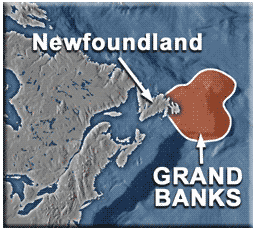 The Grand Banks are among the world's largest and richest resource areas, renowned for both their valuable fish stocks and petroleum reserves. Situated off the southeast coast of Newfoundland, the Grand Banks are actually a series of raised submarine plateaus with a water depth ranging between 120 and 600 feet and spreading for a length of about 350 miles.
Relative shallowness allows extensive marine animal and plant life to flourish on the bottom. Further, the warm waters of the Gulf Stream pass over the southern portion of the Banks in winter, but cover almost all of the Grand Banks in summer.
The most prolific fish species on the Grand Banks has traditionally been cod, but there also are flounder, haddock, ocean perch and hundreds of other species.
Portuguese and Basque fishermen fished the Grand Banks as early as the 1400s, but it was not until after John Cabot's voyage to the New World in 1497 that knowledge of the Banks and their valuable fishing resources spread throughout Europe. The Banks have been continually fished since that time by fleets from England, France, Spain, Portugal and later Newfoundland, Canada and the United States.
The Grand Banks are among the world's largest and richest resource areas, renowned for both their valuable fish stocks and petroleum reserves. Situated off the southeast coast of Newfoundland, the Grand Banks are actually a series of raised submarine plateaus with a water depth ranging between 120 and 600 feet and spreading for a length of about 350 miles.
Relative shallowness allows extensive marine animal and plant life to flourish on the bottom. Further, the warm waters of the Gulf Stream pass over the southern portion of the Banks in winter, but cover almost all of the Grand Banks in summer.
The most prolific fish species on the Grand Banks has traditionally been cod, but there also are flounder, haddock, ocean perch and hundreds of other species.
Portuguese and Basque fishermen fished the Grand Banks as early as the 1400s, but it was not until after John Cabot's voyage to the New World in 1497 that knowledge of the Banks and their valuable fishing resources spread throughout Europe. The Banks have been continually fished since that time by fleets from England, France, Spain, Portugal and later Newfoundland, Canada and the United States.